A little while back at an event, some designers, costumers and I were discussing sewing machines—specifically which were the best ones. As a professional sewing machine tech, I was running down my short-list of favorites for them—all older models. In the middle of my sentence, one gifted cosplayer blurted “The best sewing machine is the one you can afford!” which of course, caused the conversation to abruptly cease.
It occurred to me that this cosplayer was making a lot of assumptions about value and cost with her proclamation. She seemed to assume one must buy new and that quality is directly linked to cost. It seemed that she assumed that people with fewer means must take the dregs, as if they only had one terrible option at their price point. I am here to tell you that this is not so. In the matter of sewing machines, those fancy high end $15,ooo machines are not the costumer’s machine of choice.
Let’s start with the assertion that indeed, the best sewing machine is the one you can afford. It’s the sort of thing that really goes without saying, and was exactly what I was explaining at the time. You can’t sew on a machine you don’t have. However, good machines abound at all price points. Of course, there are definitely machines we’d rather pass up, which was the other point I was making.
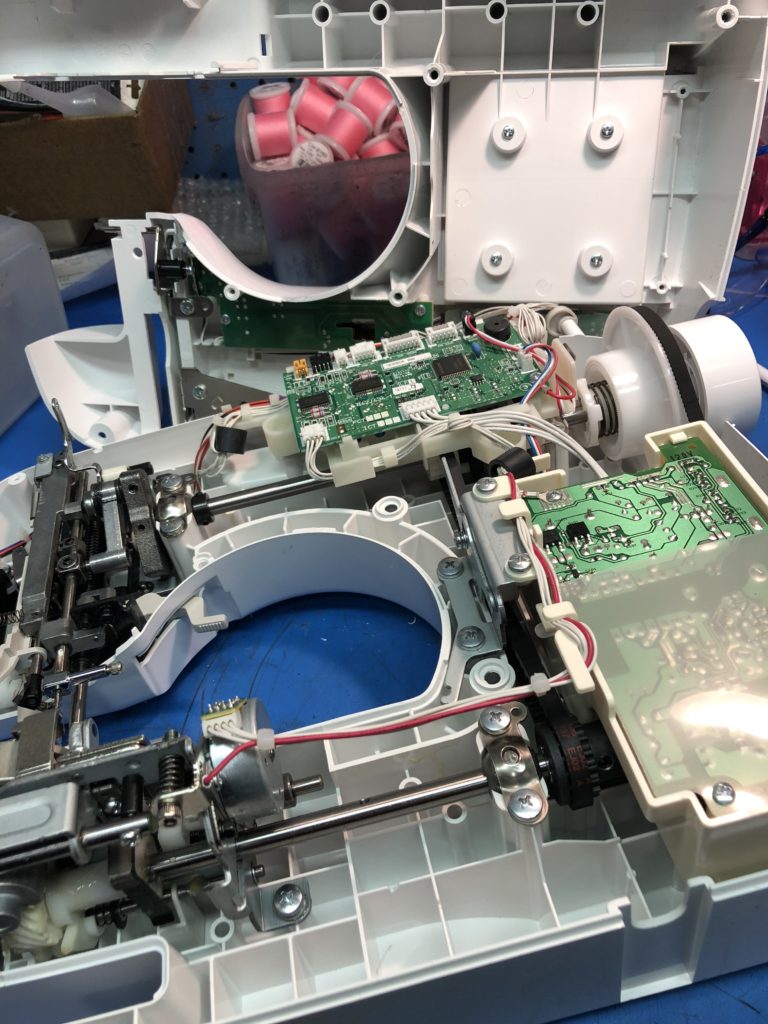
Here is the inside of a low-end Brother Simplicity. Lots of plastic. No metal frame. You’ll do better with a used vintage machine, and pay less for it, too. Because it is lightweight, this might be great for travel, or for a child to learn on, but not for the hard use of a costumer. Goes for about $116, new.
Wasting money on junk is more of a tragedy for the budget sewer. At its worst, it can halt sewing until money is saved up again with which to purchase another machine. It is this fact that led me to my career in sewing machine repair in the first place. I found that it’s best to collect information first, rather than buy two sewing machines like I did. Also, do not rely on old information. You will only end up dreaming of the machine you could have had, or perhaps you’ll be mourning the loss of the big project you can no longer build. I am looking at you, person buying that inexpensive machine everyone has heard of, from that famous fabric chain store—even if it does have “Heavy Duty” printed on it.
For sure, the best value is a used machine—across the board, and is usually my preferred choice. A used machine is also quite often better than a new machine. This is because the quality of sewing machines is not what it once was. Price point, and having more stitches than one could ever use, is what is driving sales now. For this article, we will look at mechanical machines, as they are often the best machines out there.
As whole, older machines—from the 90’s and earlier—are generally built to a different standard. Back in the day of simple zig zag sewing machines, we expected them to last forever, and generally they did. We bought just one and used it for our entire sewing careers, and then we would give it to our daughters.
When the step motor came into use, a whole world of embroidery stitches opened to us, which changed the sewing machine’s role in our lives. It also meant that we needed a wider bite on our zig zag so our designs would not be limited to 4mm wide, and so, stitch quality began to suffer. The addition of an embroidery module with hoop is a whole topic not covered in this article. We are only looking at sewing machines here.
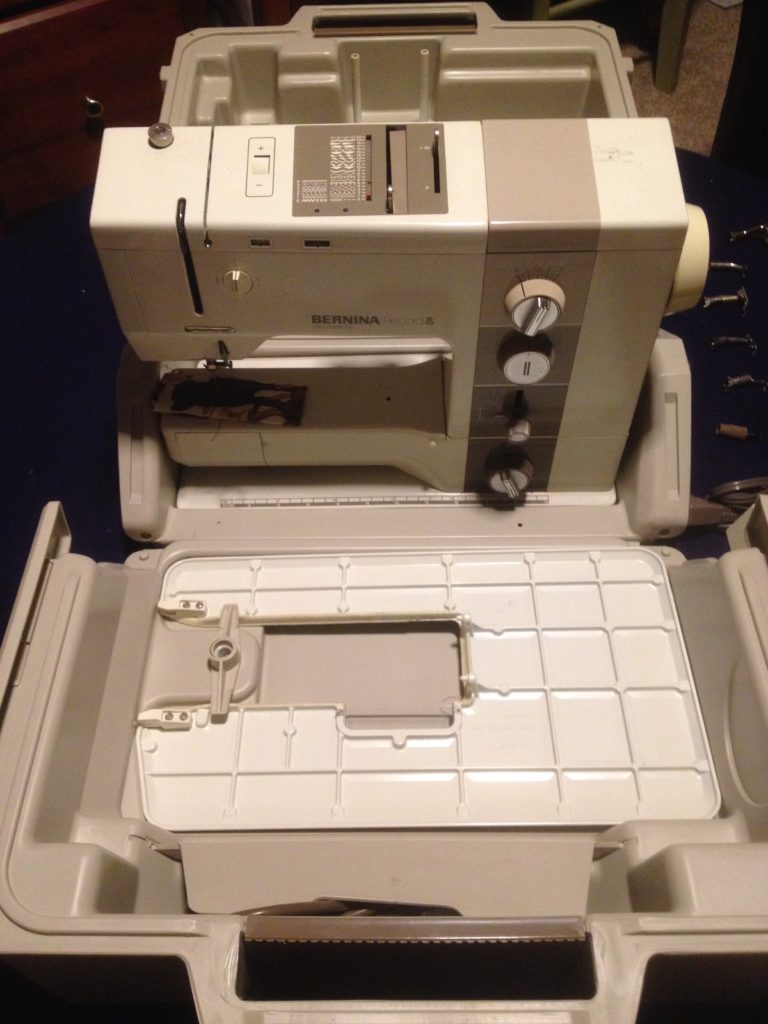
The Bernina 930. Been sewing on mine for over 30 years. It is responsible for making the smoothest piping, the most beautiful satin stitch and the most effortless ripple-free seams. She is my partner, and I owe her a lot.
Though most of the older machines are a good choice, there are a few coveted machines that you’d be well served to search out. These include the Bernina 930, 830 Record, 801/801S/802, and the rotary semi-industrial 940 (this is a real dream to sew on!), all from no later than the 90’s.
Currently these can be gotten for about $150 to $500, with the 801/801S/802 at the low end of that scale. If you score one of these in good shape, you will never need another sewing machine. They sew everything. I have even made baldrics out of tooling leather on my Bernina 930. They represent a time when stitch quality was valued, and there was not a step motor in sight. They are absolutely beautiful in design and engineering.
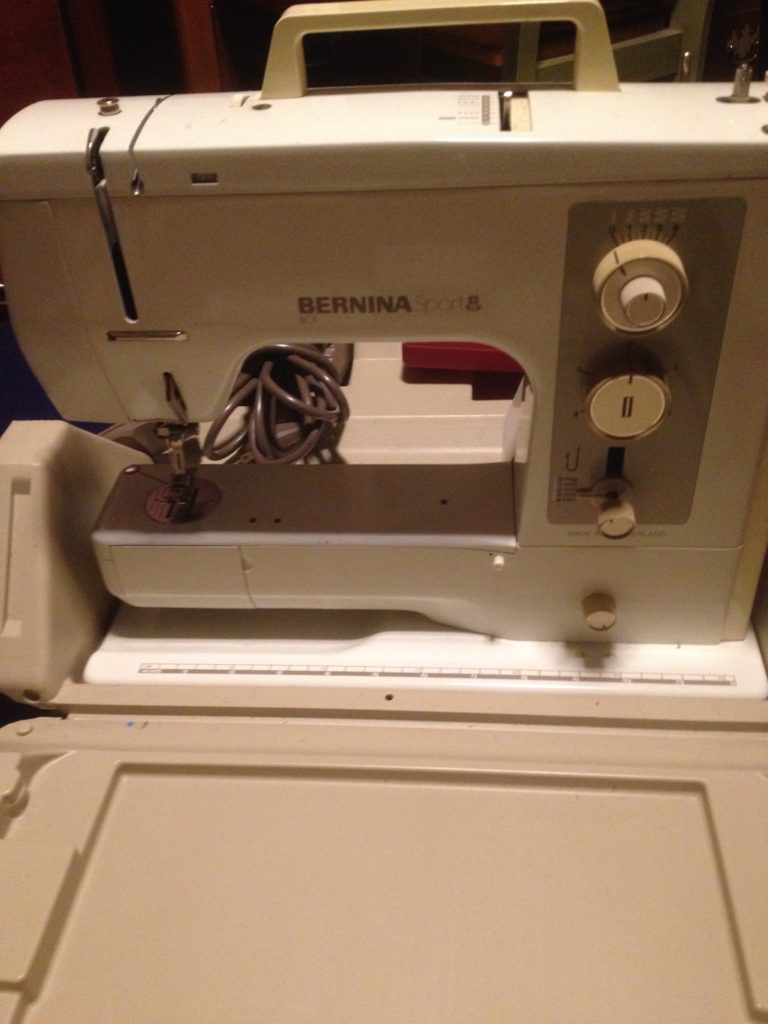
Bernina 801 Sport. The best “little” machine out there. This is what I travel with. Fits in the overhead in a carry-on suitcase. Yes, TSA opens it. There is also a dark red (vs the taupe) version.
The 830 Record/801/801S also have no circuit boards, or sometimes only a small one that is easily repaired/replaced if it fails. You will still find them, and other mechanical models of Bernina, in professional theater costume shops everywhere because they were simply the only ones that always worked. Pro tip: some of the Bernina 830 Records have a counterweight eccentric that is covered in nylon. These can crack with age and your machine will have issues. The part is no longer available. Pop off the free arm cover and look to see if this nylon is on the counterweight before you buy.
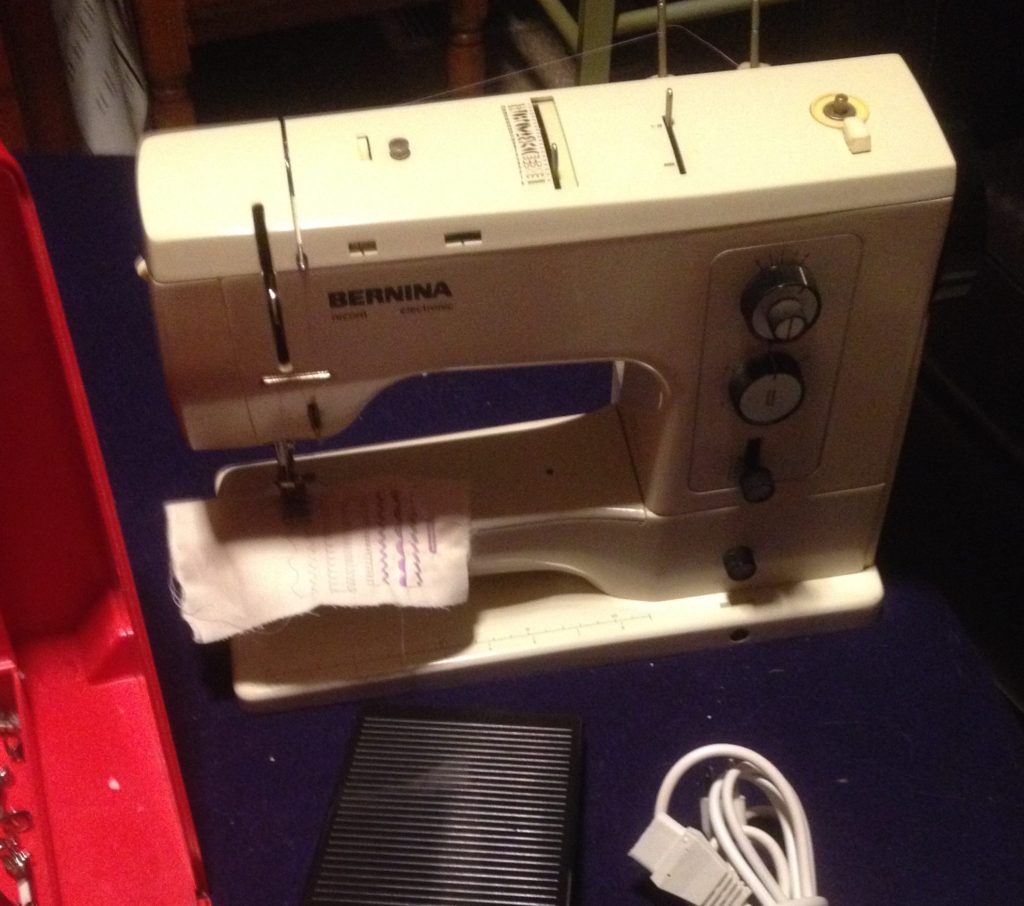
Bernina 830. Probably the most coveted of all machines. It is a bigger version of the 801/802, with more decorative satin stitches. No stretch stitches. Like the rest in the suite it has a killer beautiful buttonhole.
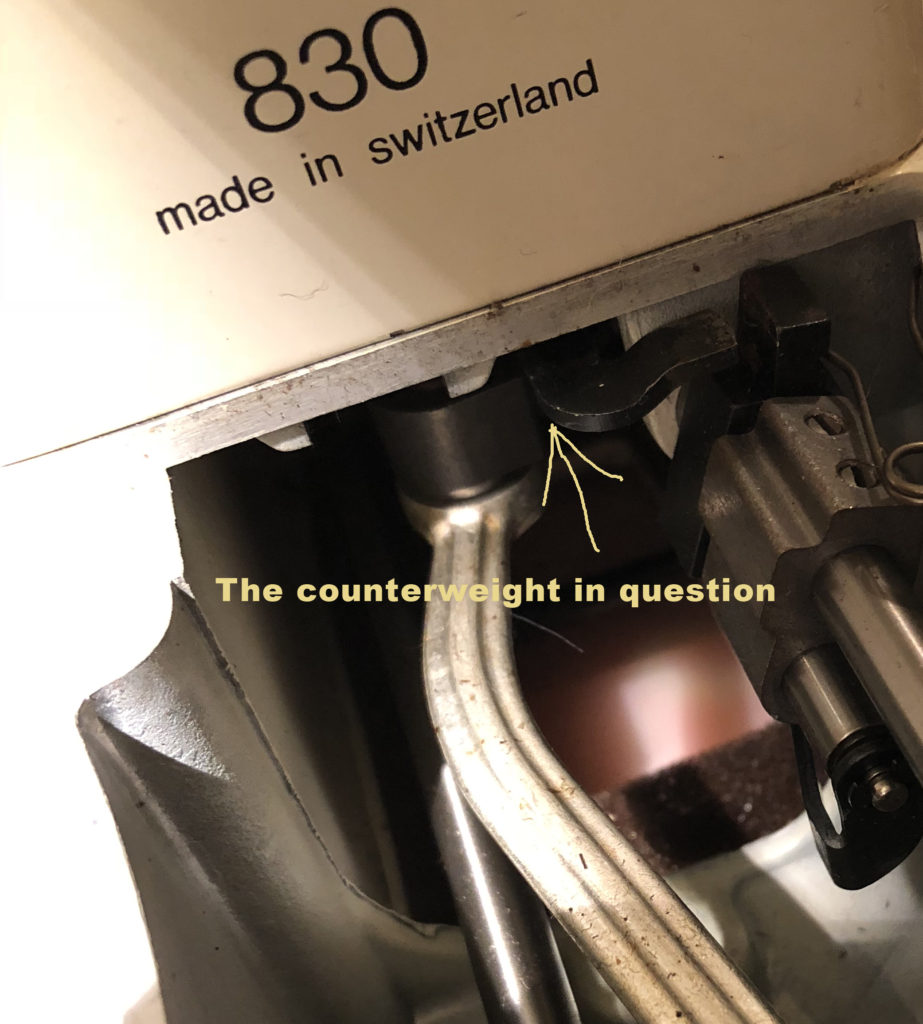
The counterweight is in there. Can’t miss it. It is the big round cylinder of metal attached to the bent aluminum crank.
The older Pfaffs, like the Tiptronics (the 2020, etc), Tipmatics, and the other machines of that era (spot them by their body shape: all similar to the Tiptronics) are also a good choice, though the base plate circuit boards can be an issue. Often, it’s just a loose connection that can be re-soldered. Sometimes it’s more than that. It’s possible to get the circuit board repaired, but at the going rate of $150 for the machine, it’s cheaper to just buy another. These machines offer a nice stitch quality, are quiet, and offer decent speed. Yes. Quiet matters. You won’t truly understand why until you spend time sewing on a quiet machine and realize how stressful your last noisy machine was.
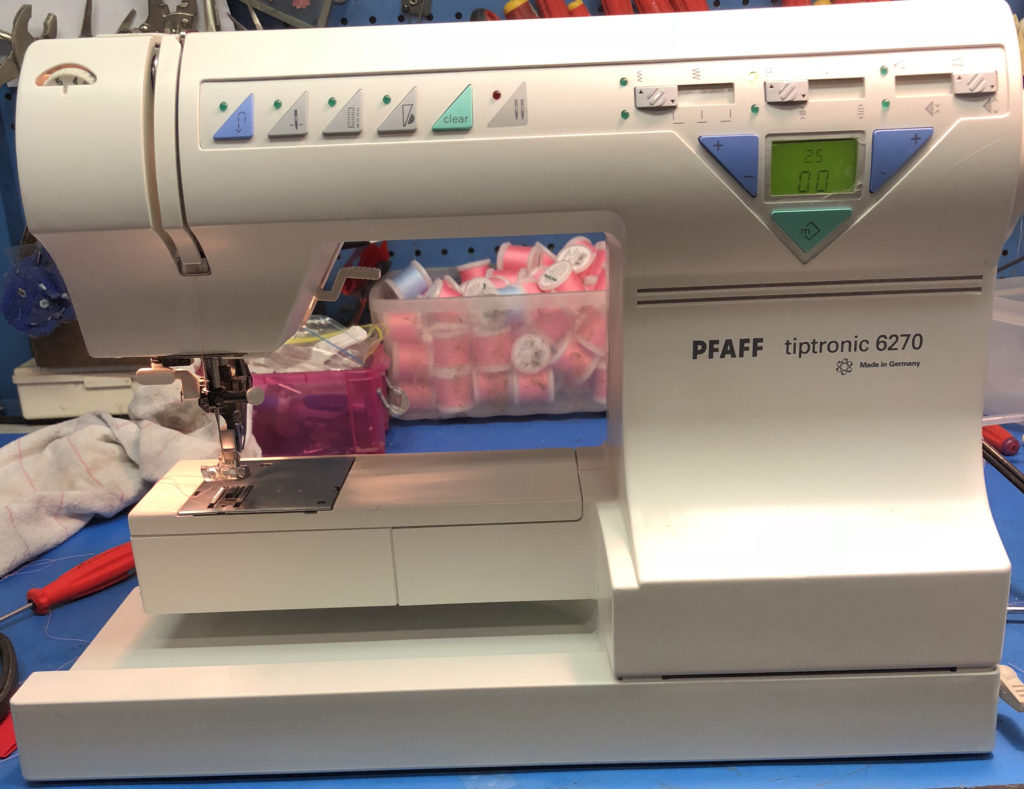
One of the nice little Pfaffs: Quiet, and has a killer buttonhole. This one was made in Germany. Others were made in Czechoslovakia.
Another big score is the Pfaff 130 or 230. Built like a tank, and twice as heavy. Find one for about $250. Be sure that all the knobs turn and slide freely. As they age, if they have been tucked away in Grandma’s attic, they will get gummy and stuck. Sometimes they can be freed up again, sometimes not. These machines will sew even the thickest coutille bundle, and are beautifully fast. No ploddingly slow work here!
Sears Kenmore from the 70’s or earlier are also a good bet. They are sturdy, simple, and cheap. I won’t list the model numbers as they are not in plain view on the machine, are filled with decimal points and pretty much no two are alike. You can get one for under $50. They all have metal housings, are heavy, and are a great deal.
Then there are the wilds of your local thrift shop. Beware. Here there be demons. You will find a surplus of Singer sewing machines here, mostly Touch ‘n Sew models filled with disintegrating gears and making ugly y-shaped zig zag stitches—if they sew at all. Occasionally you will find an Athena 2000. If you do, stop and marvel at the 1970’s Radio Shack EC-420 calculator as expressed as a sewing machine, then move along.
Let me make it clear that Singer has not made a sewing machine that met my needs since the 1960’s. In general, avoid them. They will usually need all their gears replaced. There are so many other, better machines you could own at that price point instead. The worst offenders are the 600s-700s models. If you see these, hide them, so no one else will have the ill luck of buying them. I am being hyperbolic, but that does not mean that I am wrong.
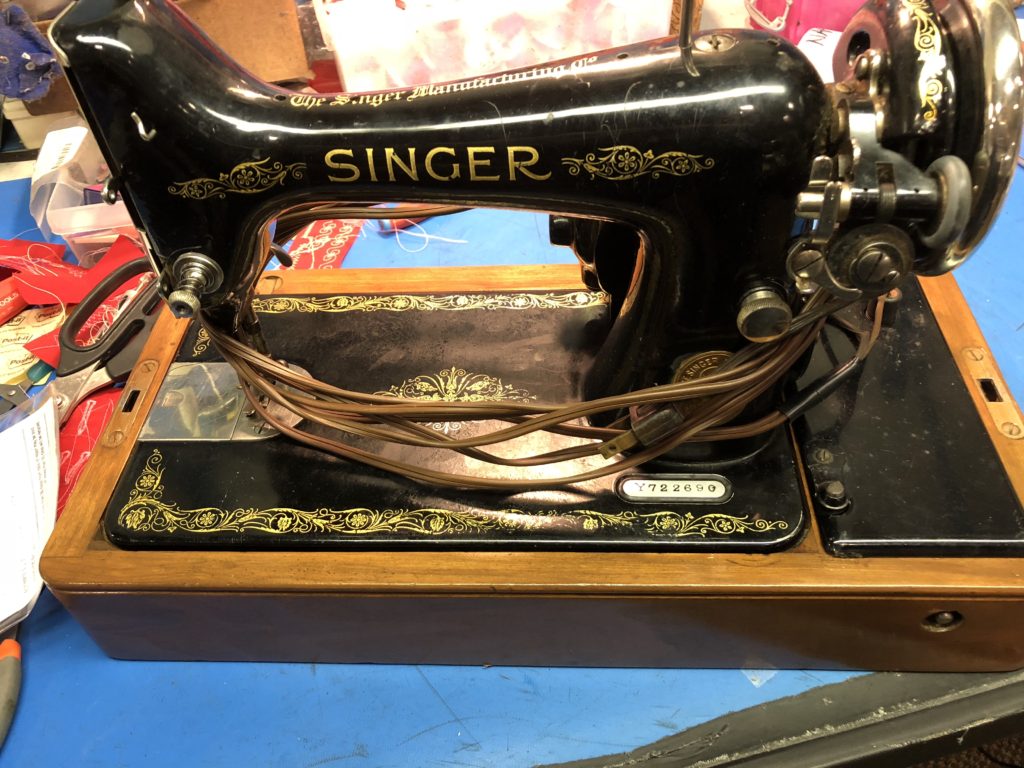
Singer 99k. If you find one of these and you love the look of it, go for it. You’ll need to put a motor kit on it: new motor, power cords and foot control. This model is from 1922, and the wiring, as with all of them, is bad. The connectors are no longer available. Be safe. Replace it all.
You may be lucky to find a few gems strewn in with the chaff while shopping thrift stores. You can still find the Singer Rocketeer (500/503) for about $100, but for far less at the thrift stores, which typically price vintage machines at $50 or less. The quirky shape is endearing, and it’s got a decent stitch with enough power to “make it sew.” The 301 and 401 are also a good choices. The icing on the cake is that there is a guy (or two) on eBay who repaints the the 301s and 221s in all sorts of bright colors. Sewing on a neon purple sewing machine for the win! A bonus with these old Singers is their buttonhole attachment. Sew the same size buttonhole, every time, beautifully. Please skip the 201 as they are too old, and the wiring will be bad. You can’t replace the motor, so it’s pretty much useless.
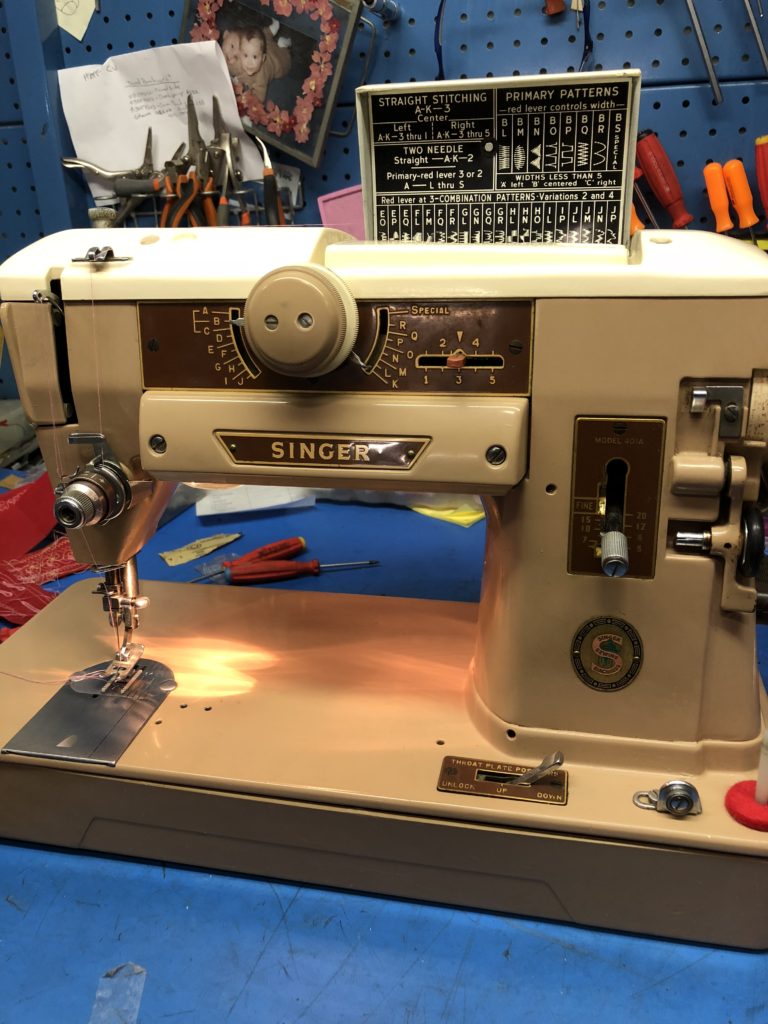
Singer 401, in the Rocketeer family. Pretty good little machine with all metal gears. Use the mechanical buttonhole attachment.
Though not really a costumer’s machine, a discussion of vintage sewing machine would not be complete without the Singer Featherweight (221). It is a favorite of quilters. It’s a small straight stitch machine meant for simple cottons, but might be just what you need if you travel a lot. It comes in a small black box, and is adorable. These are in high demand and command a $250 price tag—the later white 60’s models go for slightly less. The rare free-arm models go for well over $1000. This high demand also means that parts are available, including the motor and hook assembly.
There are also a lot of post-war Japanese “badged” machines with names like Fabri-Matic, Good Housekeeper, Vogue Stitch, and Bel Air. Badged machines are simply a machine made for retailer with space to put their own name on it. These machines were made possible because of US economic reform in Japan after WWII, hence the numerous quantity of them. ISMACS has over 5000 badge names in their records, all produced by a handful of makers. Right now, Janome makes most of these low-end machines.
Badged machines, though often noisy, are pretty good buys as you can get them for $25 or less Be picky because some have cracked gears or guides that cannot be replaced. Generally, if it’s a basic straight or zig zag machine, you are golden. If it has fancy stitches, you may still be golden, or you may not have any access to the fancy stitches, which still may be okay for your needs if the price is good enough. There are so many of these types of machines out there that they need to be considered case-by-case. Look closely at these. These are not good machines, but they are bargains that you might even get for free. They often look like a ’57 Chevy dashboard, so they have a whimsy factor as well.
Clearly there are a great many good machines at a low price available to us. They are no more expensive than the cheapest new machine, and far exceed them all in quality. Go get that machine you can afford. Just make it one that will be a pleasure to sew on, and not a battle.
Buyer’s checklist:
• Always check to see if there is actually a motor, and that it works.
• Check for cracks in the housing.
• Check the gears to be sure they are still pliable.
• Check to be sure the foot control is included. New foot controllers can be expensive.
• Check for rust. Too many machines end up stored in the basement, garage, or barn, to their detriment.
• Turn all the knobs to see if they might be broken or stuck.
• Check the wiring for crumbling covers, or bare wire. Be sure to look at the wires coming from the motor as well as the power cord.
• Plug it in, thread it up, and see if it makes a stitch.
• It’s aways a good idea to have a tech service a used machine before you put it into service.

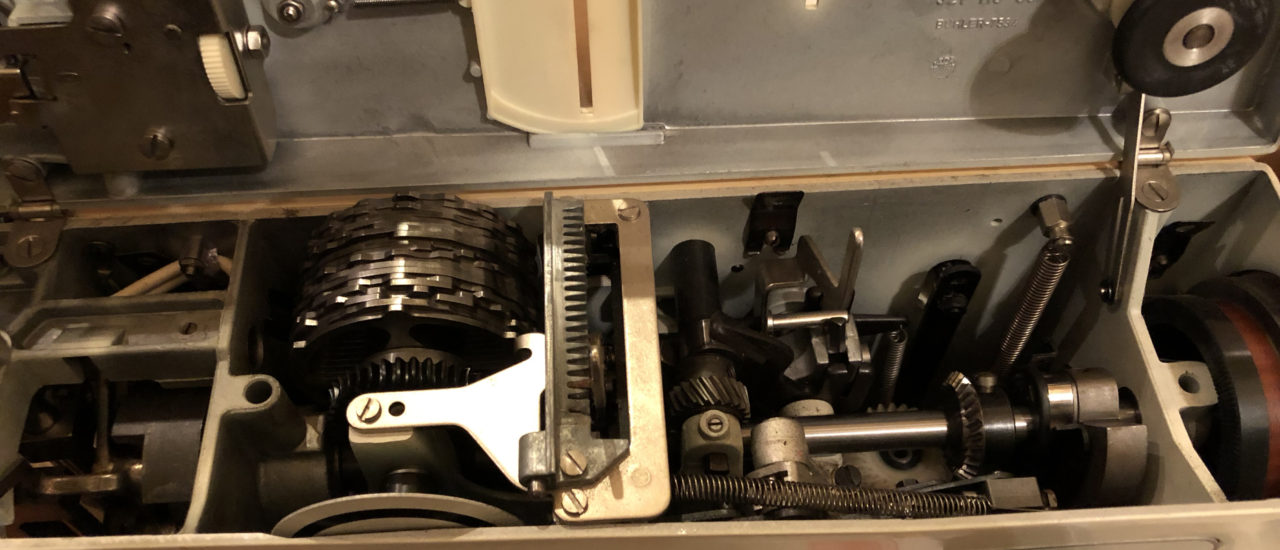
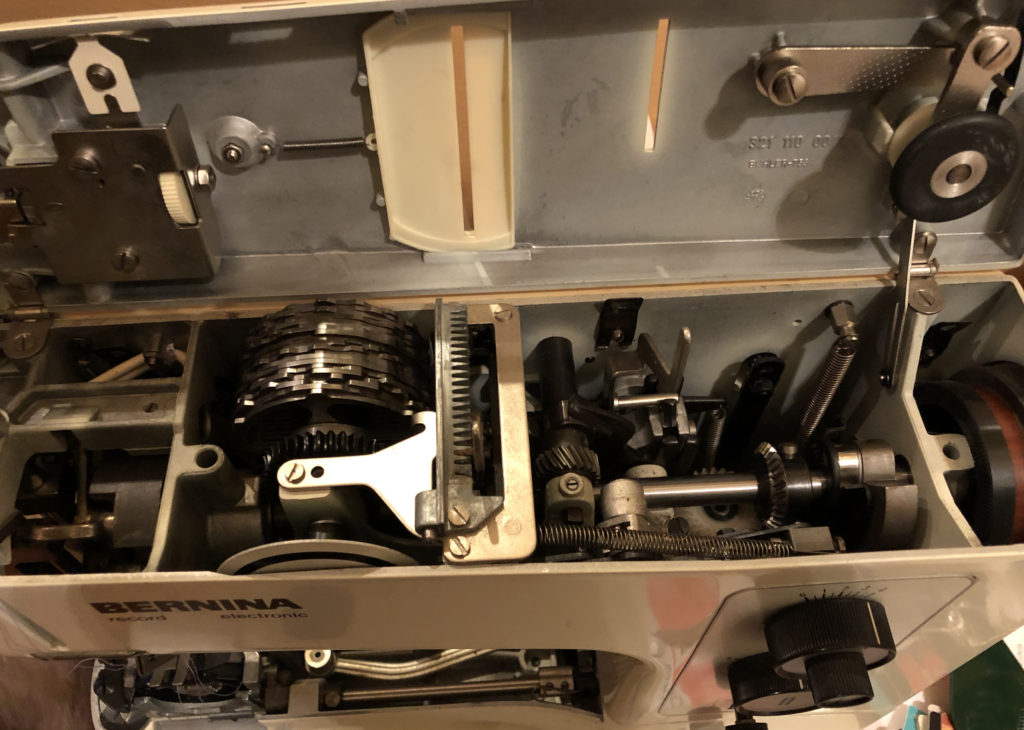
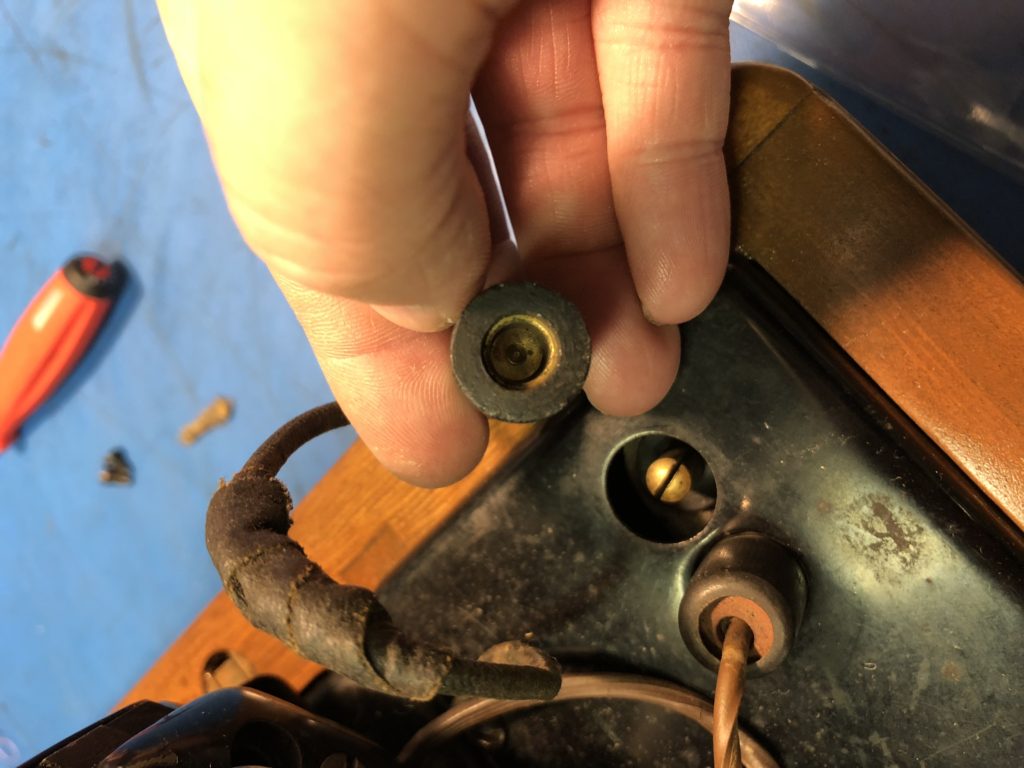
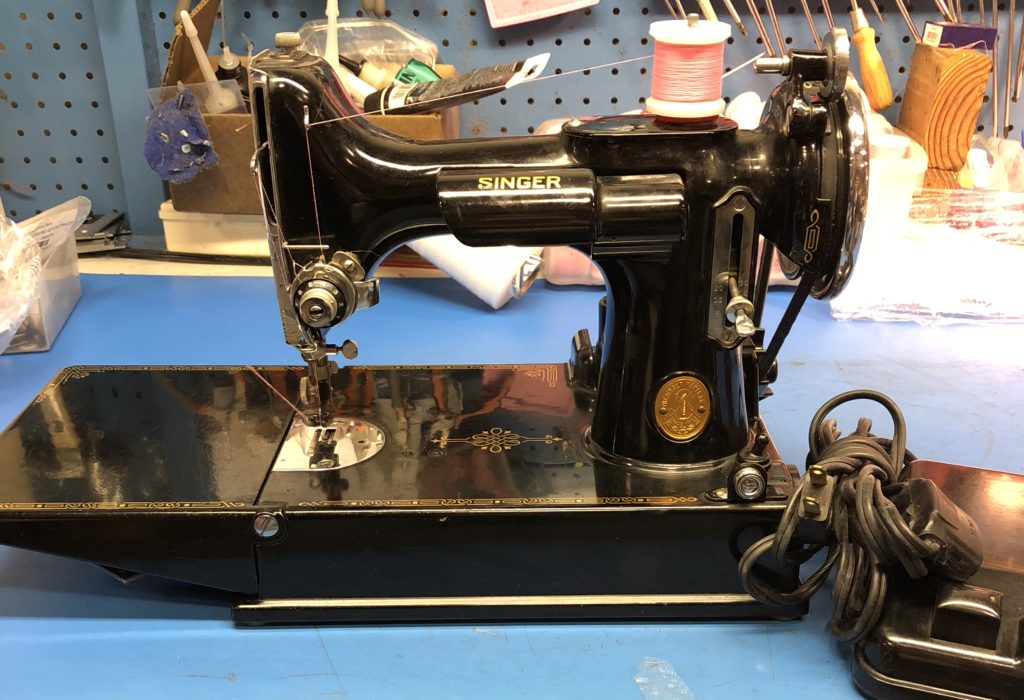
Thanks for the great article!
What a great article from the person who knows! Thanks very much for the succinct mental shopping list.
I replaced my well-loved 1974 Kenmore with a Husqvarna Scandinavia 200 a few years back. It’s ok, but I really miss that Kenmore. (The local repair place could not find the needed replacement part, alas, or I would still be using it.)
Thanks for sharing your knowledge and experience. This was a very informative article.
This is amazing! I am on the hunt as our family Kenmore from the 1960’s is gone now and I’m sewing/quilting on the junkiest “new” Kenmore that doesn’t even sew a straight stitch and the tension is ridiculous all the time. I see soooooo many options on eBay… well-explained, good listings… would you ever recommend ebay for vintage purchases? If not, where online would you go? Many thanks if you’re able to answer. <3
I have bought on eBay, but I am a repair tech. Usually things go fine, but I have had machines arrived poorly packed, and I have had UPS run over a machine I packed for sale. eBay is okay, but try for a local auction where you can do a pick up instead of shipping.
Don’t buy on e-bay! I purchased a beautiful 1960’s Pfaff from e-bay, but sadly the seller didn’t pack it well and it was pretty beat up when it got to me. Ridiculous e-mails ensued.
True, eBay can be hit or miss. Insist that they use UPS and have UPS pack it and insure it. I have done this several times when shipping machines, all with good results. They cannot say it was not shipped properly, as they packed it. It does cost more, but it’s worth it. I went to this after UPS ran over one of my Bernina 801 machines with their truck and insisted it was my fault. There were tire tracks on it. I took a real hit on that one, but I did replace the machine for the customer.
I was reading a quilting magazine and an article talked about the Singer Featherweight. It said the featherweight wasn’t the ideal machine for quilting , because the featherweight should not be used continuously , its motor is not powerful enough for the demands of quilting. It is best used for regular garment sewing.
David, that is not true. Quilters love these little machines. The motors are just fine. If, in fact you DO go through a motor (after all, they are over 50 years old, at least), because this machine is so loved, you can get a new motor for it. Alphasew makes them.
I only piece on my Featherweight machine. I would never try to quilt on it because throat areas isn’t large enough. I get perfect seams on my Featherweight and I can take it completely apart to clean and oil. Best buy ever and just bought a 2nd one to have someone come over and sew with me.
Quilting is not recommended on the Featherweight, but it’s perfect for assembling the quilt pieces. It also rocks for quilting retreats.
Love the Bernina 801, 830 . 930 and so on. Very reliable machines made to a high standard not found in the newer modern machines of today.
I remember my mom buying her Bernina 830 around 1976 and it was a big deal as it cost $500.00. Today in 2019 it still works!
Sara
I bought my 930 in 1983 for $999. I could sell it for that price now. Worth every penny, and more.
I bought my 930 in 1984 fir $1,200. I just made 150 masks for pandemic use and was thinking—is it time fir a new machine? But perhaps not. It still sees like a champ. I love it.
Hi! Came to your site from comments on vintage machines on FB’s Self Sewn Wardrobe and am hoping you won’t mind giving me some advice. I have my mother’s Singer (in cabinet) which I think is a 201K and probably not used since 1983. After comments from SSW, I’m considering having it professionally cleaned to use for heavy-duty projects (including my son’s new love of re-upholstery). My repair person (who I think is quite experienced) has said it needs lots of cleaning, a new belt, and new wiring. He says he’d used wires like what the featherweights use (one instead of two cords [?]). He’s estimating it could run up to $350, though we could be surprised by it starting up and running smoothly once he does the new wires. Above you say to skip the 201s since they’d need a new motor…I think what he is saying is that he’d rewire the motor…
What do you think about spending $200-$350 on getting a Singer 201K working again?
Thanks in advance! (and if you don’t choose to answer, I totally get it!)
Yes. If he can rewire it, that would also work. Not many places will do that. Personally, I’d still spend that on a used Bernina 801/830R/930, but that is only personal preference.
I use only Brother machines. I have had a b
Brother for over 13 yrs and paid under 200$. I feel if your machine does hor you what you need to do then all is good. I have a back up machine that is a Brother also and my daughter payed 50$ for it. Works great. I have had it for around 10 yrs
Brother is good, provided its not their low-end machine. Their embroidery machines are great.
I inherited my Mother’s 1942 manufactured date Singer model 66. I was third generation to sew on it when I was a kid. Unfortunately the machine got old and so did I. The coating on the wires dried out and none of the local sewing shops in my area of Massachusetts would handle it saying there was no guaranty they could get it in working order. This past year I found a wonderful store in Connecticut who took it on with no moans and groans. It’s running like a top and I have brought other sewing machines there and have been delighted upon getting them home to run perfectly again.
Those older Singers are great. Just keep an eye on the wiring.
My Viking 500 was an 25th anniversary gift. We’re now celebrating 50 years. My Beloved Viking had a power switch that was faulty. The repair guy told me the after market switch wasn’t great & sold me a Viking Sapphire 930. It’s nice but doesn’t sew as quietly & the satin stitch is as nice. Not made in Sweden. Made in China. I’m still kicking myself. Should have just had the switch replaced.
Yes most are China nowadays. Sometimes Vietnam. Viking and Pfaff are made by the same people now—even have some of the very same parts. Your repair guy was right. The after market parts are really not very good, but I hear you.
The most important thing is service. I purchased a Brother serger new, it continuously caught the lower looper thread on the wrong side. The local dealer charged me $75.00 and did not fix it.
You should take it back to them. A good dealer will stand behind their work. Ask them to thread and sew with it in front of you. That way you can find out of it’s operator error or an actual mechanical issue right then and there. They should help you either way.
Great information, thank you! My sister gave me her Bernina 801 sport recently and I love it, but would like to get my hands on a sewing table assessory that snaps in as described in its manual or a new one that will fit it. Any thoughts on where it find one? Thank you. And again thank you for the glowing review of this machine…I’ve been debating if I should get a newer full sized machine, but am put off by the too many stitches I won’t need, the plastic, and computerization…showing my age!…now I can be proud of my little vintage number. Xo Stevie
Yes, you can find them on eBay, or you can try Quality Sewing and Vacuum (Qualitysewing.com). I know for a fact that they had a large supply of vintage clip-on trays on hand. Just be sure you are specific with the model number as the 801 sport has a different body shape than the 801 (they are the same inside) and they take different trays. Drop them a line. They will ship. info@qualitysewing.com
Problem with having an old machine like my Bernina 801, is that you can’t find certain parts.
You can find many parts second hand. Some parts are still made. The good thing is you probably won’t need any parts.
Your opinion on a Bernina 950? I have found one in excellent condition for $800 and a 930 for $1000.
Bernina 950 is GOLD. Snap that one up. It is a rotary machine, so it is faster than the 930. It is a “semi-industrial.” Both machines are wonderful, though.
Enjoyed hearing about the Bernina s. I was recently gifted s Bernina 330. I got it turned on but not sewing. Can you tell me more about the machine. It embroiders with a pes7.0. My notebook is a 10.4. Will I need upgrade on the bernina(I’m dont know if it had any.) I’m wondering if my notebook will support the 7.0. Thank you kindly
It sounds like it might be a circuit board. Might also be the foot pedal. For these computerized machines, I suggest you take it in to your local repair shop.
I’ve loved my Bernina Favorit 740 for 40 years and sadly, the motor died. With an external motor, my savvy hubby contacted our BerninaMan who gave us a tip so hubby finally managed to dismantle the motor and now we wait weeks for 2 new brushes for that same motor. (My old order Mennonite family very much wanted me to trade for it because it has an exterior belt…so they could switch it to a treadle.) That did not seem right. As we wait, I picked up my elderly mother’s old ’60s Kenmore (made by Singer) and even with brittle cords, it cleaned and oiled up nicely but it runs much slower and with uneven stitches…much like a toy to me. The third machine of mom’s is a Bernina 930 and after cleaning and oiling, it hummed nicely– for almost 3 minutes until the pop/crack and pouring smoke. I’m making dozens of custom covid face masks (older daughter a lab tech) so I was very dismayed to not have any machine at all after so much effort. Our college-at-home children collaborated–hours of completely dismantling the 930 to the circuit board and detecting the fried capacitor. The daughter (age 17/accounting) found the number, the son (age 20 ME student) did the dismantling and retrieval, and older son (age 22 cyber security student) ordered some capacitors and 2 weeks later, rebuilt the circuit board. Finally yesterday, the skillful hubby took half a day to reassemble. AND it Worked! Once the 740 brushes arrive and my ‘Favorit’ runs again, Lord willing, I’m hoping to then have enough machines to teach all 3 daughters to sew! I am blessed. Berninas are amazing machines.
Oh, I ADORE your repair team!
I have a Golden Touch N Sew Singer purchased the month of October 1966. It runs great except my light literally disentgrated. I bought an LED light strip and taped it to the Machine. I am back to being a HAPPY CAMPER. I had a sewing machine guy tell me my machine was outed and useless. At the time it was bought it was considered top of the line. It does almost everything that a new machine does except you can’t get the needle to rethread itself automatically. That I am still able to do by myself. I am very happy with my Singer I also own a Benjman Treadle machine that is real old that I learned to sew on when I was 5 years old. I am now 77. It still runs real good and the gadgets for it are just like the ones that come with the new sewing machine. By the way my husband keeps my sewing machines running great.
We do become attached to our machines. I will not be replacing my Bernina 930 ever, either. That LED trick is the way to go. Just be sure to attach it so it does not cross any of the machine’s covers. If you need to bring it in for service, your repair tech will have to remove it to get the machine open, and they don’t always stick back on again. We don’t really need all the bells and whistles of the new machines. We just need a good zig zag, and decent stitch quality. The Golden Touch ‘n Sew is my absolute nemesis, though! It was my first gear job and it was particularly hard to remove the lower shafts and the stitch length lever out of the way to replace the gears. The gears on the Touch ‘n Sew models often disintegrate, and need replacing. If your machine suddenly does not sew correctly, it might be the gears. Get them all done at once, because if one goes, they will all go, as they are all made from the same stuff.
Thank you for the excellent information and for validating the decision to seek out and keep older machines. I recently took my much-loved Bernina 801 for a tune-up, and another customer caught sight of the number and said, “You have an 801. Don’t ever part with it.” I assured her that I wouldn’t, and, let me tell you, it felt great to have that wonderful machine appreciated by someone other than my trusted tech. I bought it about 35 years ago and haven’t looked back. There is such a push to buy plastic, flashy, expensive machines with lots of bells and whistles. I’m with you. I want a machine I can rely on that does the basics well. Thank you!
Likewise with my 930. I also keep an 801S for my travel machine. They are the best!
Great information! Curious if you’ve had any experience with the Viking 6570. I have one I purchased in 1980. It’s been a great machine over the years, but now it does not feed properly and the stitching is uneven. I’ve moved to a different state since the last time I tried to have it repaired and was told parts were no longer available and there wasn’t much they could do. Wondering if I should donate it or try again to find someone that can repair it. Appreciate your thoughts.
Viking 6570 is a lovely machine.It’s worth taking it in for service. Last time I worked on one, I needed to replace the feed dog lift eccentric. You can still get this part. The shop I worked at would not charge anything if we could not get parts, so it really is worth taking it in.
I have a kemore that bought in 1960 .Made all my childrens clothes and my husbands shirts and my clothes . Had to stop bobbin stopped working .It would slip when trying to wind .They told me the. Part was no longer made. Bought Viking 990 and having trouble with regulating stitch
Hello, I have a 1984 New Home Memory Craft 6000. It has been a great machine for all these years. The only issue I have with it is the throat space. I am doing more quilting. I am considering purchasing a new machine for more throat space. Any suggestions? Thank you!!
The Pfaff machines have a bit more between the needle and the body of the machine. The best option, however, for quilting are the actual quilting machines. The other, cheaper option is to assemble the quilt top and send it off to someone else who has a quilting machine set-up to do the actual quilting. This leaves you free to put your energy into the art of the quilt top. I’d still suggest a used machine if you are wanting to purchase.
I really enjoyed your article! I have been sewing for years on vintage machines. I had a Husqvarna Viking 6020, but I wore it out. In looking for a replacement, I found the Bernina sewing machine. I bought a Bernina 1031 from a lady that said it couldn’t be repaired. Took it to a Bernina dealer and had a gear replaced and it’s been sewing great since! The buttonhole is what got me hooked on Bernina’s! Very nice quality! Now after a few years I have an 801 and I just found a 940 semi-industrial. I also have a Pfaff 145 industrial with a walking foot. My youngest daughter has a 1030 and a 950 industrial as well. They really are nice machines. The great part is all of the feet interchange!
The new machines cannot compare.
Hi, thank you for the great article. I’m wondering if you can give a little advice. I know that the older machines are better made and can’t be beaten but I had a very bad experience with used machines, with all the money spent in used one I could afford a new one. I owned, in the past, a Paff semi industrial and was excellent machine, quiet, speedy and very straight beautiful stitches. Now I have a Brother sewing and embroidery machine. It’s a good machine, I can’t complain but has a small space from the needle to the arm and made difficult to do a big quilt. Since I have a back problems I don’t want to fight trying to fit my quilt in the space but also I don’t want to send my piece for quilting, I enjoy the process. I’m between Pfaff and Husqvarna Viking but they have too many models. I want a machine with the things that a home quilters need, nothing too fancy, but will be great to have the stitch adjustments made by the machine insted of my self, (I’m not good at it). Make garments, I love to do jackets and dresses and have a little bit embroidery capacity. Again, thank you for the article.
Lili
You know, for you, I’d suggest a used industrial. You can get a basic straight stitch machine for about $400. The arm is generally longer than any home machine now, and and does not cost the thousands nor takes as much space as the big quilter machines on a frame. Not much can go wrong, if you get one that is all mechanical. You can even swap out motors cheaply. I have a Bernina 217, which by rights is really a semi-industrial as it does not have an oil pan.
I have an Elna bought in the 1970’s it has been a workhorse. All metal has cams that are plastic. Had gears replaced once was told that it was a sought after machine. Often thought I should get a newer machine with more features. Lately machine has been hesitating when I step on pedal. Think maybe that needs replacing. Can I just buy any power cord with pedal? Would like your thought on this machine. Is it a good machine to keep? Was made in Switzerland or Germany
The Elna is indeed a sought after machine. If the machine is hesitating, I would first look at the foot control. It’s likely there is a capacitor that needs to be replaced. A quick check is it try it with another foot control that would fit your machine.
Are there any vintage or older Husqvarna models that you would recommend?
Any of the old Viking/Husquarvana machines are good. Anything before the 1990’s
Bought my Bernina 930 in 1984 for $1500.00 but it came with a cabinet. Will never part with this machine. It’s a workhorse. I also own a Bernina 640 but it does not measure up to the 930. Seems to give me problems all the time. I do use the embroidery module from time to time. There are a,so 2 feather weights and a singer that I inherited. Never got that machine figured out. It came with these discs. I will stick to my Bernina 930 for most of my sewing. It is too heaving to haul to retreats.
Sadly, I left my table behind when I moved to Ireland. I run my 930 (and my Bernette 334DS Serger) on a transformer now. Can’t buy a machine as good as the 930.
I got married in 1975 and one of the presents that got the MOST use (other than a set of sheets for the bed and kitchen goods) was an avocado green Kenmore that had a simple zig-zag and “manual” buttonhole adjustments (right, left, and the zig-zag “bridge” for the ends – you had to count how many stitches it took & hope that both sides had fed evenly – which didn’t always happen on corduroy and some knits). I sewed a new wardrobe for myself and the machine was replaced with a new one about 1981 – another Kenmore, but with stretch stitches and an automatic buttonhole attachment that I sewed with until 1996. My current workhorse is a Singer 328k with all the fashion discs (33 cams, if I counted correctly last week), in a vintage cabinet, and I found an original accessories box with the feet, manual, and other odds & ends still in it on eBay (bought in 2018 and still in use). I also have a Bernette serger, a Bernette cover stitch machine, two Husqvarna Viking Topas 30 sewing & embroidery machines (that I bought for myself), and a Pfaff QE 4.2 (fell in love with the embroidery stitches on it – but have only used MOST of them once, for a “sampler”). I have a couple of Singers (the embroidery machine was a gift from my husband and the other was bought on sale to leave at my daughter’s house 850 miles away from home – for use when I visit her). I also bought a refurbished entry level Eversewn and LOCKED it up tight after owning it for less than two years – it might have been that I was trying to use it for something that it wasn’t heavy-duty enough, it might have been that it sat for too long between trips (bought for use when traveling by car), or it might have been “something else”. The repair costs for a completely locked machine (hand wheel would barely move if you tried to “wiggle” it) were going to exceed the replacement costs. It is no longer my problem. I also have an HV Jade 35 (embroidery & sewing version) – which I used for about 4.5 years – turns out it’s considered a machine for beginners (a good one, due to the number & size range of hoops – but the motor is not up to the more densely stitched designs that I was using it for – NOT being a beginner with machine embroidery – I’ve been doing a fair amount of embroidery most years since 2006 or so – mostly for family & friends – but one project turned into an annual one for a local school, where my husband was teaching). That project taught me that it is cheaper to buy new hoops in different sizes than it is to buy another embroidery machine to get an extra size (or more than one extra size) of hoop.
Where do you find parts for vintage Berninas? I have a Vintage Bernina 802 Sport needs a thread take up lever, Stitch width knob/dial and stitch length knob/dial. I need to widen my WWW search for take up lever but not sure what other vintage Bernina models have same thread take up levers.
Side note: I have a Bernina 930 Record, a Bernina 807 Minimatic, and Bernina 800DL overlocker/serger. LOVE LOVE LOVE them. Also have a Bernina B820QE that I do not like at all. I will be selling it soon on eBay. I guess I got spoiled with ease of my vintage Berninas.
Nothing compares to the vintage Berninas. You can get camstack gears at Sewingpartsonline dot com. For the take-up you will need a donor machine, or a hunt through ebay. Perhaps your local Bernina dealer. Some of the knobs are available as 3D print files. YEAH! Some you can replace with a generic knob that happens to fit. Generally, the same number sets all fit the same:801/802 etc. all the 830/831/832, and so on.You can get the exploded parts books for these on line. Another wonderful source is facebook. Check out “Vintage Bernina Sewing Machines”. There are a couple of pages. (and I am still serging away on my 334DS!)
Will a sewing table for Bernina 801 fit my Bernina 830 Record Electonic (old style)?
Any advice about where to purchase a table for my 830 would be much appreciated.
Assuming you mean the clip-on table, the 801 table will not fit your 830, as the 801 is a smaller machine. Also, the 801 has 3 tables, depending on when your machine was built. If you are stalking about a piece of furniture, it’s possible the 801 table would fit your 830, but you’d need to get the correct insert for it. That all depends on the table, as some are very machine specific, some are not. In lieu of the Bernina clip-on table, some people really like those large plastic quilting tables that can be ordered for a specific machine. As for the Bernina clip-on table, you can try Quality Sewing and Vacuum n Seattle at 1(800) 687-5175.